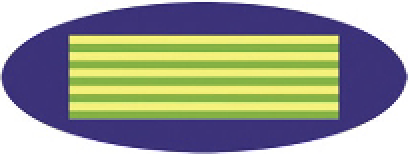Biomedical Engineering Reference
In-Depth Information
chapter promise exciting applications but are
still under development and not quite suitable
for mass production. So far, industrial adop-
tion is confined to the fabrication of multilayer
structures and block copolymers with a periodic
modulation of refractive index in one direction
(one-dimensional photonic crystals) and the fab-
rication of three-dimensional photonic crystals
based on self-assembly of colloids.
polyamide) through an especially designed
metal mold mounted on a spinning head. The
first reported fiber consisted of 61 alternate lay-
ers of polyamide (nylon 6 with mean refractive
index of 1.53) and polyester (mean refractive
index of 1.63) with thicknesses in the 70-90-nm
range. The multilayer core was embedded in a
polyester of thickness 15-17
μ
m and then flat-
tened
[125]
. The structure was designed for high
reflectance at 470-nm wavelength to correspond
to the
Morpho
blue with maximum reflectance.
The manufactured fiber exhibited clear color
and a luxurious metallic gloss, and its color
changed subtly with the viewing angle.
As it is a non pigmented fiber, its production
is friendly to the environment. Due to the simi-
lar refractive indices of the alternating polymer
layers, the spectral regime of high reflectance is
much narrower than that of the
Morpho
wings.
Although the beauty of the fiber does not match
that of
Morpho
butterflies, it is quite suitable for
many applications, including for dye-free uphol-
stery and dresses, because of the flatness of the
fiber; see
Figure 11.26
. It is also easy to diversify
the color range of the manufactured fibers sim-
ply by changing the thicknesses of the constitu-
ent layers.
Dispersal of minute granules (not of pig-
ments) in the two layers of the fiber also pro-
duces color, provided the granular substance is
properly chosen, similar to the production of
Tyndall blue in nature. For example, a structur-
ally colored fiber was manufactured in the form
of a yarn or filament with a coaxial structure of
alternating layers of polymers with refractive
indexes
n
a
and
n
b
satisfying the condition
1.1 ≤
n
b
/
n
a
≤ 1.4
[127]
. Minute granules consist-
ing of at least one material selected from the
group of calcium carbonate, zinc sulfate, zinc
white, lithopone, cadmium sulfate, chrome
oxide, rutile, and anatase were dispersed in the
first or the second plurality of transparent layers.
The granules have a size equal to or less than
1.25
μ
m and a refractive index
n
c
, which satisfies
the twin conditions
n
c
−
n
a
≥ 0.4 and
n
c
−
n
b
≥ 0.4.
11.6.2.1 Structurally Colored Fibers and Surfaces
A very striking contemporary application of
structural colors produced by a multilayer
photonic structure is the structurally colored
fiber and a fabric woven with that fiber. Nis-
san, the Japanese automobile company, claimed
the world's first successful reproduction of the
Morpho
color in an engineering application: non-
circular structurally colored fiber fabricated by
the conjugated melt-spinning method
[125, 126]
.
The sketch in
Figure 11.25
illustrates the idea of
the structurally colored fiber. As discussed in
Section
11.4.1
, the underlying concept is con-
structive interference from alternating layers of
two polymers with different refractive indexes
n
a
and
n
b
, and thicknesses
d
a
and
d
b
, respectively.
When the ratio of the refractive indexes obeys
the condition 1.01≤
n
b
/
n
a
≤ 1.20, white light at
normal incidence is selectively reflected back for
a wavelength
(11.4)
λ
=
2 (
N
A
D
A
+
N
B
D
B
) .
The fabrication of the fiber consists in alterna-
tive passing of molten polymers (polyester and
FIGURE 11.25
Schematic of the structurally colored
fiber fabricated by Nissan Motor Co. A periodic multilayer
comprising alternating layers of two polymers with differ-
ent refractive indexes and different thicknesses is encased in
a polyester cladding.

